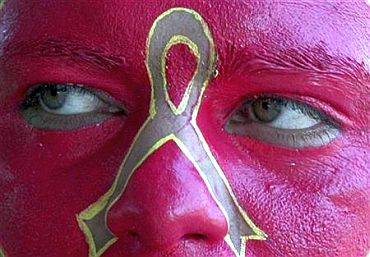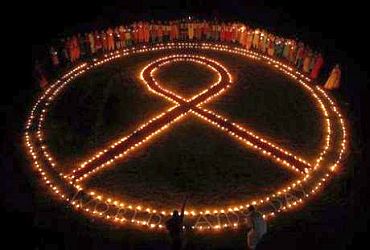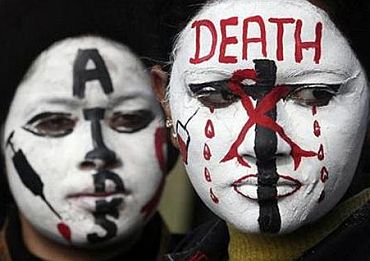Photographs: Reuters
In good news for the fight against HIV/AIDS, government studies show that the prevalence of the pandemic amongst the adult population across the country has seen a steady decrease over a four-year period beginning 2004.
According to statistics released by the National AIDS Control Organisation, in 2004 the number of people afflicted by HIV/AIDS were 0.41 per cent of the population, in 2005 0.39 per cent, in 2006 it was 0.36, in 2007 it was 0.34 and in 2008 it was 0.29.
Of the total 2.61 million people afflicted with HIV/AIDS in 2004, 1.02 million were women, while in 2008 of the total 2.27 million, 0.90 were women.
The data shows that the epidemic has been stabilised in the four high prevalence states of Maharashtra, Tamil Nadu, Karnataka and Andhra Pradesh, said K Chandramoui, Director General of NACO.
...
Number of AIDS cases is declining in India
Image: Students hold oil lamps beside a symbol of AIDS to mark the World AIDS Day in ChennaiPhotographs: Reuters/Babu
However, there are trends indicating the rising HIV epidemic in other moderate to low prevalence states.
Except Andhra Pradesh with HIV prevalence of one per cent, all other states have shown less than one per cent median HIV prevalence.
Trends among Injectable Drug Users are on a decline in Manipur, Nagaland and Chennai, while they are rising in Meghalaya, Mizoram, West Bengal, Mumbai, Kerala and Delhi.
Among IDUs, Maharashtra, Manipur, Tamil Nadu, Punjab, Delhi, Chandigarh, Kerala, West Bengal, Mizoram and Orissa have shown high HIV prevalence of more than five per cent.
Number of AIDS cases is declining in India
Image: College students display HIV/AIDS awareness messages on their faces during a face painting competition in ChandigarhPhotographs: Ajay Verma/Reuters
Expanded surveillance has revealed more than five per cent HIV prevalence in states such as Karnataka, Andhra Pradesh, Manipur, Maharashtra, Delhi, Gujarat, Goa, Orissa, Tamil Nadu and West Bengal.
Among female sex workers, there is a decline in southern states, reflecting the impact of interventions, while rising trends are evident in the northeast, which suggests the dual nature of the epidemic.
An overall decline in HIV prevalence among ANC clinic attendees is noted at all India levels and in high prevalence states in south and northeast.
Except Andhra Pradesh with HIV prevalence of one per cent, all other states have shown less than one per cent median HIV prevalence among ANC attendees.
Number of AIDS cases is declining in India
Image: A HIV-positive woman holds a placard during an awareness rallyPhotographs: Rupak De Chowdhuri/Reuters
A rising trend is seen among ANC clinic attendees in some low and moderate prevalence states.
Unprotected sex (87.1 per cent heterosexual and 1.5 per cent homosexual) is the major route of HIV transmission, followed by transmission from parent to child, which is 5.4 per cent and use of infected blood and blood products which is 1.1 per cent.
While injecting drug use is the predominant route of transmission in northeastern states, it accounts for 1.7 per cent of HIV infections nationally.





article